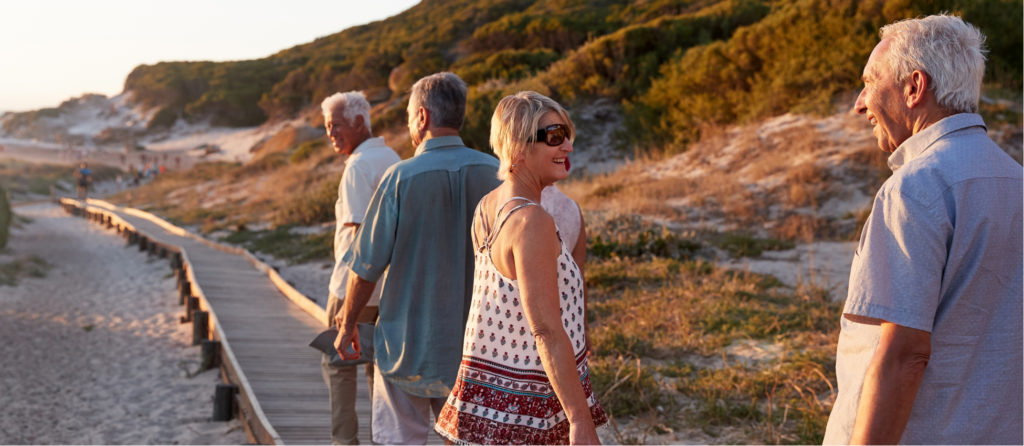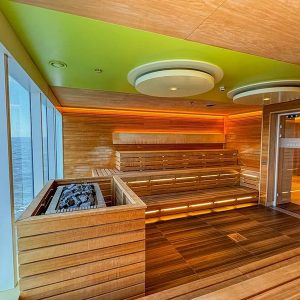Delhi – both new and old
Cows wandering nonchalantly down busy city streets, oblivious to vehicles and noise. This was my sole memory of Delhi 20 years ago, so we were keen to reacquaint ourselves with India’s capital.
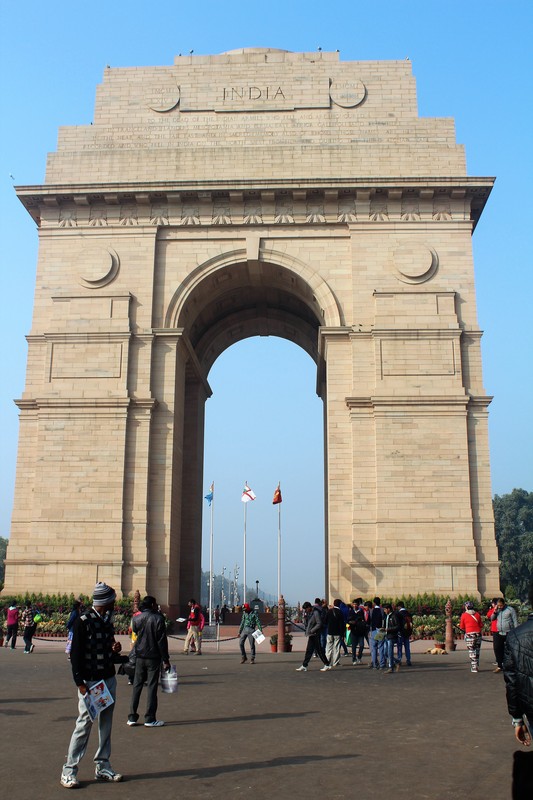 In New Delhi, we drove up a wide, ministry-lined avenue to Rashtrapati Bhavan, formerly the Viceroy’s House and designed by the British architect Edwin Lutyens. We peered through the smog down a long drive to what is now, the President’s official home.
In New Delhi, we drove up a wide, ministry-lined avenue to Rashtrapati Bhavan, formerly the Viceroy’s House and designed by the British architect Edwin Lutyens. We peered through the smog down a long drive to what is now, the President’s official home.
Nearby, the tall imposing India Gate, also designed by Lutyens, is dedicated to 90,000 Indian soldiers who died fighting alongside the British in World War 1. It also bears the names of 3,000 British and Indian soldiers killed on the Northwest frontier whilst a bronze cap, rifle and flame commemorate those who lost their lives in the 1971 Indo-Pakistan war. Domestic tourists, stray sleeping dogs and hawkers, selling chai and pani puri, all mingled contentedly.
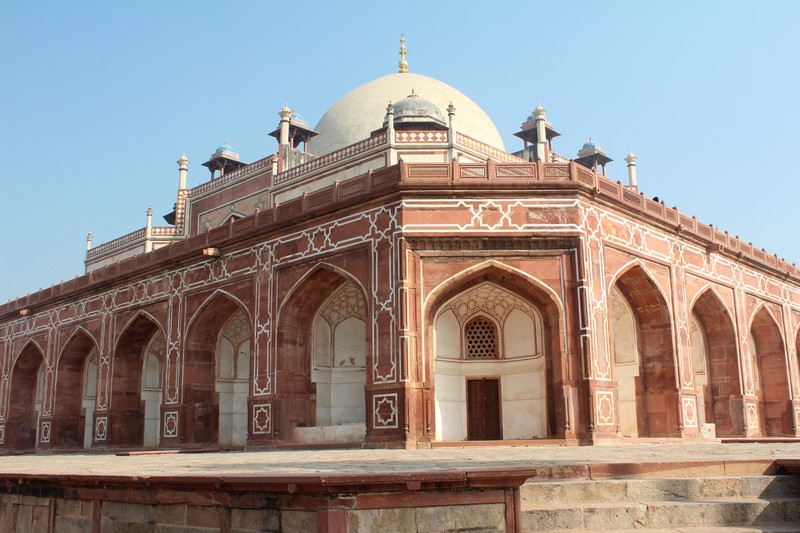 Next was the tomb of Humayun, the second Moghul emperor, built in 1564 and designed by his widow. It was an impressive red sandstone, black and white marble affair, in equally grand grounds. Our guide, Dennis, regaled us with a lengthy, complicated story of how Humayun lost Delhi and his father’s empire to a rival, but regained it before his death. Humayun’s barber was buried near him: according to the Rough Guide ‘he was considered important because he was trusted to hold a razor to the emperor’s throat’. Dennis said it was because they were in a homosexual relationship!
Next was the tomb of Humayun, the second Moghul emperor, built in 1564 and designed by his widow. It was an impressive red sandstone, black and white marble affair, in equally grand grounds. Our guide, Dennis, regaled us with a lengthy, complicated story of how Humayun lost Delhi and his father’s empire to a rival, but regained it before his death. Humayun’s barber was buried near him: according to the Rough Guide ‘he was considered important because he was trusted to hold a razor to the emperor’s throat’. Dennis said it was because they were in a homosexual relationship!
Whilst New Delhi gave a sense of space, peace and tranquillity with broad, tree-lined roads and light traffic, this was in stark contrast to Old Delhi which assaulted all our senses.
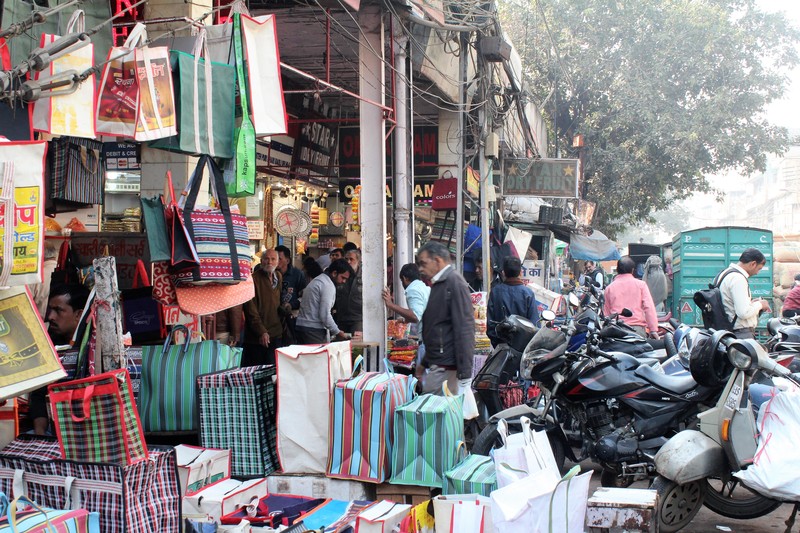 We experienced Chandni Chowk, Old Delhi’s main thoroughfare, in auto rickshaw, on foot and cycle rickshaw. The street was a seething mass of people with cars, rickshaws, tuk tuks, and motorbikes constantly blowing their horns and weaving round those still wandering cows who stopped occasionally to nose through gutter garbage. At one point, everything came to a complete standstill as cars tried to cross a road against the lights. The Highway Code has not reached Old Delhi.
We experienced Chandni Chowk, Old Delhi’s main thoroughfare, in auto rickshaw, on foot and cycle rickshaw. The street was a seething mass of people with cars, rickshaws, tuk tuks, and motorbikes constantly blowing their horns and weaving round those still wandering cows who stopped occasionally to nose through gutter garbage. At one point, everything came to a complete standstill as cars tried to cross a road against the lights. The Highway Code has not reached Old Delhi.
Small shops brimmed with colourful displays of dried fruit, rice, nuts, spices and chillies. Climbing rough concrete stairs to a balcony warehouse, we met men carrying huge hessian sacks of spices on their heads, coughing and spluttering due to the pungent smells.
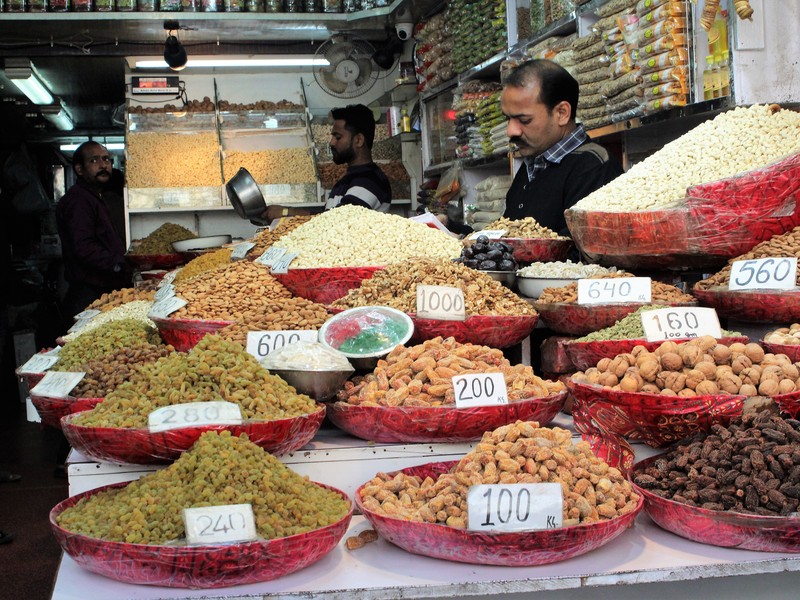 A narrow bazaar was lined with shops selling wedding-related goods: red saris, jewellery, embellishments, gold and glittering gemstones. A banana skin landed on the floor in front of us and, looking up, we spotted the culprit: a red-bottomed monkey scampering along the rooftops and a tangle of electricity cables. A tempting aroma and queues led us to stalls selling fresh chapattis stuffed with radish, potato, onions and chillies.
A narrow bazaar was lined with shops selling wedding-related goods: red saris, jewellery, embellishments, gold and glittering gemstones. A banana skin landed on the floor in front of us and, looking up, we spotted the culprit: a red-bottomed monkey scampering along the rooftops and a tangle of electricity cables. A tempting aroma and queues led us to stalls selling fresh chapattis stuffed with radish, potato, onions and chillies.
We escaped the noise, smells and chaos for India’s largest Islamic mosque, Jama Masjid, perched on a hill, where an arched gateway led to an open courtyard large enough to accommodate 25,000 kneeling worshippers.
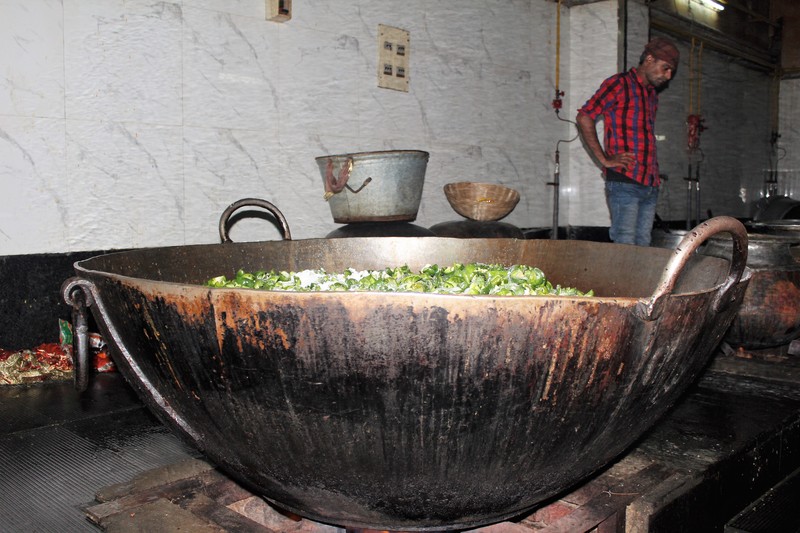 At the Sikh temple, Bangla Sahib Gurudwara, we removed shoes, covered heads and washed feet and hands. Whilst the gold, crystal chandeliers and musicians playing devotional music were impressive, it stood out for its humanity. Daily, up to 20,000 people, from all religions and backgrounds, patiently queue for a free meal. In a huge hall, they sit cross legged on long, beige coir mats and wait for a ladleful of dal served from a bucket and two chapattis. In the kitchen, a group prepared a mountain of cauliflowers and red onions with streaming eyes and another cooked machine-made chapattis whilst industrial-sized woks bubbled with dal. Food and time are both given freely by devotees.
At the Sikh temple, Bangla Sahib Gurudwara, we removed shoes, covered heads and washed feet and hands. Whilst the gold, crystal chandeliers and musicians playing devotional music were impressive, it stood out for its humanity. Daily, up to 20,000 people, from all religions and backgrounds, patiently queue for a free meal. In a huge hall, they sit cross legged on long, beige coir mats and wait for a ladleful of dal served from a bucket and two chapattis. In the kitchen, a group prepared a mountain of cauliflowers and red onions with streaming eyes and another cooked machine-made chapattis whilst industrial-sized woks bubbled with dal. Food and time are both given freely by devotees.
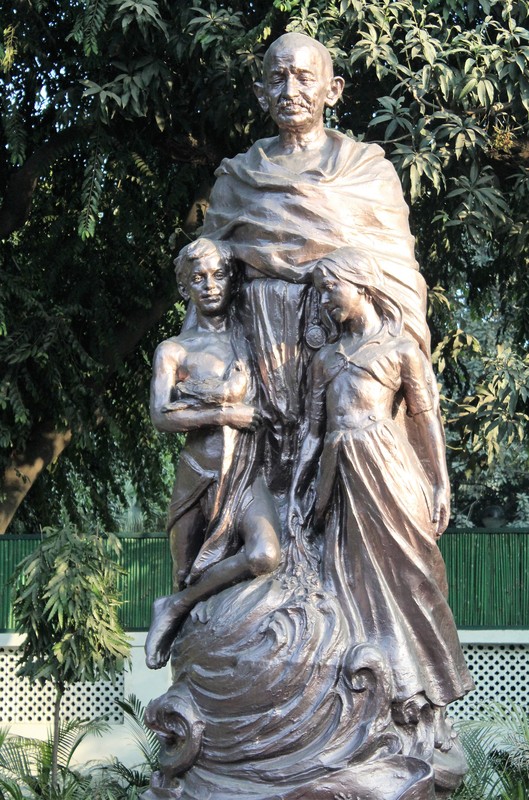 Our day’s sightseeing finished at Gandhi Smriti where Mahatma Gandhi spent the last 144 days of his life before being assassinated on 30 January 1948. His small room contained his frugal personal effects and concrete foot prints poignantly depicted his last walk from the house to a grass area where two assailants stopped him, one touching his feet as the other pulled a gun. From an exhibition of murals and photographs, we learned that on leaving India to study in London, Gandhi promised to give up women, wine and meat and eventually became a member of the London Vegetarian Society. At the exit, a larger than life statue of Gandhi with a boy and a girl holding a dove, glinted in the last of the day’s sunshine.
Our day’s sightseeing finished at Gandhi Smriti where Mahatma Gandhi spent the last 144 days of his life before being assassinated on 30 January 1948. His small room contained his frugal personal effects and concrete foot prints poignantly depicted his last walk from the house to a grass area where two assailants stopped him, one touching his feet as the other pulled a gun. From an exhibition of murals and photographs, we learned that on leaving India to study in London, Gandhi promised to give up women, wine and meat and eventually became a member of the London Vegetarian Society. At the exit, a larger than life statue of Gandhi with a boy and a girl holding a dove, glinted in the last of the day’s sunshine.
Our full-day city tour, only touched the surface and it would be easy to spend more time in the various museums and temples. As we relaxed with an end-of-day Kingfisher beer back in our hotel we mused on what we’d remember about the city in 20 years’ time. Possibly the wandering cows?
Helen stayed at The Claridges in New Delhi. Read her review.
